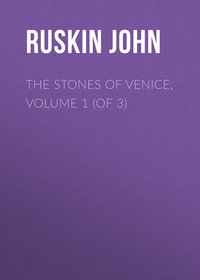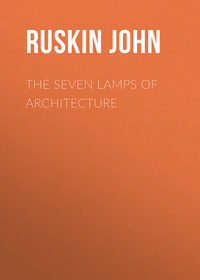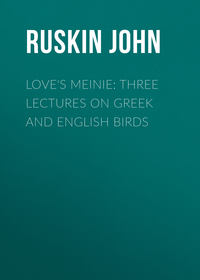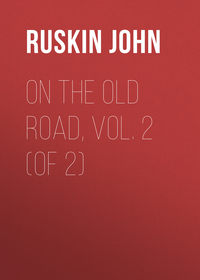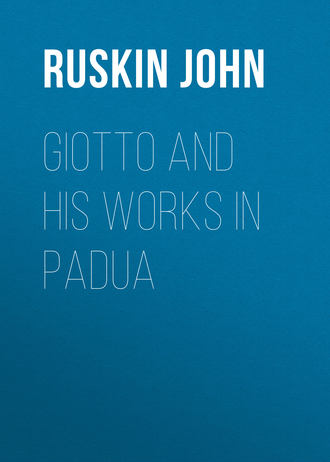 полная версия
полная версияGiotto and his works in Padua

John Ruskin
Giotto and his works in Padua / An Explanatory Notice of the Series of Woodcuts Executed for the Arundel Society After the Frescoes in the Arena Chapel
ADVERTISEMENT
The following notice of Giotto has not been drawn up with any idea of attempting a history of his life. That history could only be written after a careful search through the libraries of Italy for all documents relating to the years during which he worked. I have no time for such search, or even for the examination of well-known and published materials; and have therefore merely collected, from the sources nearest at hand, such information as appeared absolutely necessary to render the series of Plates now published by the Arundel Society intelligible and interesting to those among its Members who have not devoted much time to the examination of mediæval works. I have prefixed a few remarks on the relation of the art of Giotto to former and subsequent efforts; which I hope may be useful in preventing the general reader from either looking for what the painter never intended to give, or missing the points to which his endeavours were really directed.
J.R.GIOTTO AND HIS WORKS IN PADUA
Towards the close of the thirteenth century, Enrico Scrovegno, a noble Paduan, purchased, in his native city, the remains of the Roman Amphitheatre or Arena from the family of the Delesmanini, to whom those remains had been granted by the Emperor Henry III. of Germany in 1090. For the power of making this purchase, Scrovegno was in all probability indebted to his father, Reginald, who, for his avarice, is placed by Dante in the seventh circle of the Inferno, and regarded apparently as the chief of the usurers there, since he is the only one who addresses Dante.1 The son, having possessed himself of the Roman ruin, or of the site which it had occupied, built himself a fortified palace upon the ground, and a chapel dedicated to the Annunciate Virgin.
This chapel, built in or about the year 1303,2 appears to have been intended to replace one which had long existed on the spot; and in which, from the year 1278, an annual festival had been held on Lady-day, in which the Annunciation was represented in the manner of our English mysteries (and under the same title: "una sacra rappresentazione di quel mistero"), with dialogue, and music both vocal and instrumental. Scrovegno's purchase of the ground could not be allowed to interfere with the national custom; but he is reported by some writers to have rebuilt the chapel with greater costliness, in order, as far as possible, to efface the memory of his father's unhappy life. But Federici, in his history of the Cavalieri Godenti, supposes that Scrovegno was a member of that body, and was assisted by them in decorating the new edifice. The order of Cavalieri Godenti was instituted in the beginning of the thirteenth century, to defend the "existence," as Selvatico states it, but more accurately the dignity, of the Virgin, against the various heretics by whom it was beginning to be assailed. Her knights were first called Cavaliers of St. Mary; but soon increased in power and riches to such a degree, that, from their general habits of life, they received the nickname of the "Merry Brothers." Federici gives forcible reasons for his opinion that the Arena Chapel was employed in the ceremonies of their order; and Lord Lindsay observes, that the fulness with which the history of the Virgin is recounted on its walls, adds to the plausibility of his supposition.
Enrico Scrovegno was, however, towards the close of his life, driven into exile, and died at Venice in 1320. But he was buried in the chapel he had built; and has one small monument in the sacristy, as the founder of the building, in which he is represented under a Gothic niche, standing, with his hands clasped and his eyes raised; while behind the altar is his tomb, on which, as usual at the period, is a recumbent statue of him. The chapel itself may not unwarrantably be considered as one of the first efforts of Popery in resistance of the Reformation: for the Reformation, though not victorious till the sixteenth, began in reality in the thirteenth century; and the remonstrances of such bishops as our own Grossteste, the martyrdoms of the Albigenses in the Dominican crusades, and the murmurs of those "heretics" against whose aspersions of the majesty of the Virgin this chivalrous order of the Cavalieri Godenti was instituted, were as truly the signs of the approach of a new era in religion, as the opponent work of Giotto on the walls of the Arena was a sign of the approach of a new era in art.
The chapel having been founded, as stated above, in 1303, Giotto appears to have been summoned to decorate its interior walls about the year 1306,—summoned, as being at that time the acknowledged master of painting in Italy. By what steps he had risen to this unquestioned eminence it is difficult to trace; for the records of his life, strictly examined, and freed from the verbiage and conjecture of artistical history, nearly reduce themselves to a list of the cities of Italy where he painted, and to a few anecdotes, of little meaning in themselves, and doubly pointless in the fact of most of them being inheritances of the whole race of painters, and related successively of all in whose biographies the public have deigned to take an interest. There is even question as to the date of his birth; Vasari stating him to have been born in 1276, while Baldinucci, on the internal evidence derived from Vasari's own narrative, throws the date back ten years.3 I believe, however, that Vasari is most probably accurate in his first main statement; and that his errors, always numerous, are in the subsequent and minor particulars. It is at least undoubted truth that Giotto was born, and passed the years of childhood, at Vespignano, about fourteen miles north of Florence, on the road to Bologna. Few travellers can forget the peculiar landscape of that district of the Apennine. As they ascend the hill which rises from Florence to the lowest break in the ridge of Fiesole, they pass continually beneath the walls of villas bright in perfect luxury, and beside cypress-hedges, enclosing fair terraced gardens, where the masses of oleander and magnolia, motionless as leaves in a picture, inlay alternately upon the blue sky their branching lightness of pale rose-colour, and deep green breadth of shade, studded with balls of budding silver, and showing at intervals through their framework of rich leaf and rubied flower, the far-away bends of the Arno beneath its slopes of olive, and the purple peaks of the Carrara mountains, tossing themselves against the western distance, where the streaks of motionless cloud burn above the Pisan sea. The traveller passes the Fiesolan ridge, and all is changed. The country is on a sudden lonely. Here and there indeed are seen the scattered houses of a farm grouped gracefully upon the hill-sides,—here and there a fragment of tower upon a distant rock; but neither gardens, nor flowers, nor glittering palace-walls, only a grey extent of mountain-ground, tufted irregularly with ilex and olive: a scene not sublime, for its forms are subdued and low; not desolate, for its valleys are full of sown fields and tended pastures; not rich nor lovely, but sunburnt and sorrowful; becoming wilder every instant as the road winds into its recesses, ascending still, until the higher woods, now partly oak and partly pine, drooping back from the central crest of the Apennine, leave a pastoral wilderness of scathed rock and arid grass, withered away here by frost, and there by strange lambent tongues of earth-fed fire.4 Giotto passed the first ten years of his life, a shepherd-boy, among these hills; was found by Cimabue near his native village, drawing one of his sheep upon a smooth stone; was yielded up by his father, "a simple person, a labourer of the earth," to the guardianship of the painter, who, by his own work, had already made the streets of Florence ring with joy; attended him to Florence, and became his disciple.
We may fancy the glance of the boy, when he and Cimabue stood side by side on the ridge of Fiesole, and for the first time he saw the flowering thickets of the Val d'Arno; and deep beneath, the innumerable towers of the City of the Lily, the depths of his own heart yet hiding the fairest of them all. Another ten years passed over him, and he was chosen from among the painters of Italy to decorate the Vatican.
The account given us by Vasari of the mode of his competition on this occasion, is one of the few anecdotes of him which seem to be authentic (especially as having given rise to an Italian proverb), and it has also great point and value. I translate Vasari's words literally.
"This work (his paintings in the Campo Santo of Pisa) acquired for him, both in the city and externally, so much fame, that the Pope, Benedict IX., sent a certain one of his courtiers into Tuscany, to see what sort of a man Giotto was, and what was the quality of his works, he (the pope) intending to have some paintings executed in St. Peter's; which courtier, coming to see Giotto, and hearing that there were other masters in Florence who excelled in painting and in mosaic, spoke, in Siena, to many masters; then, having received drawings from them, he came to Florence; and having gone one morning into Giotto's shop as he was at work, explained the pope's mind to him, and in what way he wished to avail himself of his powers, and finally requested from him a little piece of drawing to send to his Holiness. Giotto, who was most courteous, took a leaf (of vellum?), and upon this, with a brush dipped in red, fixing his arm to his side, to make it as the limb of a pair of compasses, and turning his hand, made a circle so perfect in measure and outline, that it was a wonder to see: which having done, he said to the courtier, with a smile, 'There is the drawing.' He, thinking himself mocked, said, 'Shall I have no other drawing than this?' 'This is enough, and too much,' answered Giotto; 'send it with the others: you will see if it will be understood.' The ambassador, seeing that he could not get any thing else, took his leave with small satisfaction, doubting whether he had not been made a jest of. However, when he sent to the pope the other drawings, and the names of those who had made them, he sent also that of Giotto, relating the way in which he had held himself in drawing his circle, without moving his arm, and without compasses. Whence the pope, and many intelligent courtiers, knew how much Giotto overpassed in excellence all the other painters of his time. Afterwards, the thing becoming known, the proverb arose from it: 'Thou art rounder than the O of Giotto;' which it is still in custom to say to men of the grosser clay; for the proverb is pretty, not only on account of the accident of its origin, but because it has a double meaning, 'round' being taken in Tuscany to express not only circular form, but slowness and grossness of wit."
Such is the account of Vasari, which, at the first reading, might be gravely called into question, seeing that the paintings at Pisa, to which he ascribes the sudden extent of Giotto's reputation, have been proved to be the work of Francesco da Volterra;5 and since, moreover, Vasari has even mistaken the name of the pope, and written Boniface IX. for Boniface VIII. But the story itself must, I think, be true; and, rightly understood, it is singularly interesting. I say, rightly understood; for Lord Lindsay supposes the circle to have been mechanically drawn by turning the sheet of vellum under the hand, as now constantly done for the sake of speed at schools. But neither do Vasari's words bear this construction, nor would the drawing so made have borne the slightest testimony to Giotto's power. Vasari says distinctly, "and turning his hand" (or, as I should rather read it, "with a sweep of his hand") not "turning the vellum;" neither would a circle produced in so mechanical a manner have borne distinct witness to any thing except the draughtsman's mechanical ingenuity; and Giotto had too much common sense, and too much courtesy, to send the pope a drawing which did not really contain the evidence he required. Lord Lindsay has been misled also by his own careless translation of "pennello tinto di rosso" ("a brush dipped in red,") by the word "crayon." It is easy to draw the mechanical circle with a crayon, but by no means easy with a brush. I have not the slightest doubt that Giotto drew the circle as a painter naturally would draw it; that is to say, that he set the vellum upright on the wall or panel before him, and then steadying his arm firmly against his side, drew the circular line with one sweeping but firm revolution of his hand, holding the brush long. Such a feat as this is completely possible to a well-disciplined painter's hand, but utterly impossible to any other; and the circle so drawn, was the most convincing proof Giotto could give of his decision of eye and perfectness of practice.
Still, even when thus understood, there is much in the anecdote very curious. Here is a painter requested by the head of the Church to execute certain religious paintings, and the only qualification for the task of which he deigns to demonstrate his possession is executive skill. Nothing is said, and nothing appears to be thought, of expression, or invention, or devotional sentiment. Nothing is required but firmness of hand. And here arises the important question: Did Giotto know that this was all that was looked for by his religious patrons? and is there occult satire in the example of his art which he sends them?—or does the founder of sacred painting mean to tell us that he holds his own power to consist merely in firmness of hand, secured by long practice? I cannot satisfy myself on this point: but yet it seems to me that we may safely gather two conclusions from the words of the master, "It is enough, and more than enough." The first, that Giotto had indeed a profound feeling of the value of precision in all art; and that we may use the full force of his authority to press the truth, of which it is so difficult to persuade the hasty workmen of modern times, that the difference between right and wrong lies within the breadth of a line; and that the most perfect power and genius are shown by the accuracy which disdains error, and the faithfulness which fears it.
And the second conclusion is, that whatever Giotto's imaginative powers might be, he was proud to be a good workman, and willing to be considered by others only as such. There might lurk, as has been suggested, some satire in the message to the pope, and some consciousness in his own mind of faculties higher than those of draughtsmanship. I cannot tell how far these hidden feelings existed; but the more I see of living artists, and learn of departed ones, the more I am convinced that the highest strength of genius is generally marked by strange unconsciousness of its own modes of operation, and often by no small scorn of the best results of its exertion. The inferior mind intently watches its own processes, and dearly values its own produce; the master-mind is intent on other things than itself, and cares little for the fruits of a toil which it is apt to undertake rather as a law of life than a means of immortality. It will sing at a feast, or retouch an old play, or paint a dark wall, for its daily bread, anxious only to be honest in its fulfilment of its pledges or its duty, and careless that future ages will rank it among the gods.
I think it unnecessary to repeat here any other of the anecdotes commonly related of Giotto, as, separately taken, they are quite valueless. Yet much may be gathered from their general tone. It is remarkable that they are, almost without exception, records of good-humoured jests, involving or illustrating some point of practical good sense; and by comparing this general colour of the reputation of Giotto with the actual character of his designs, there cannot remain the smallest doubt that his mind was one of the most healthy, kind, and active, that ever informed a human frame. His love of beauty was entirely free from weakness; his love of truth untinged by severity; his industry constant, without impatience; his workmanship accurate, without formalism; his temper serene, and yet playful; his imagination exhaustless, without extravagance; and his faith firm, without superstition. I do not know, in the annals of art, such another example of happy, practical, unerring, and benevolent power.
I am certain that this is the estimate of his character which must be arrived at by an attentive study of his works, and of the few data which remain respecting his life; but I shall not here endeavour to give proof of its truth, because I believe the subject has been exhaustively treated by Rumohr and Förster, whose essays on the works and character of Giotto will doubtless be translated into English, as the interest of the English public in mediæval art increases. I shall therefore here only endeavour briefly to sketch the relation which Giotto held to the artists who preceded and followed him, a relation still imperfectly understood; and then, as briefly, to indicate the general course of his labours in Italy, as far as may be necessary for understanding the value of the series in the Arena Chapel.
The art of Europe, between the fifth and thirteenth centuries, divides itself essentially into great branches, one springing from, the other grafted on, the old Roman stock. The first is the Roman art itself, prolonged in a languid and degraded condition, and becoming at last a mere formal system, centered at the feet of Eastern empire, and thence generally called Byzantine. The other is the barbarous and incipient art of the Gothic nations, more or less coloured by Roman or Byzantine influence, and gradually increasing in life and power.
Generally speaking, the Byzantine art, although manifesting itself only in perpetual repetitions, becoming every day more cold and formal, yet preserved reminiscences of design originally noble, and traditions of execution originally perfect.
Generally speaking, the Gothic art, although becoming every day more powerful, presented the most ludicrous experiments of infantile imagination, and the most rude efforts of untaught manipulation.
Hence, if any superior mind arose in Byzantine art, it had before it models which suggested or recorded a perfection they did not themselves possess; and the superiority of the individual mind would probably be shown in a more sincere and living treatment of the subjects ordained for repetition by the canons of the schools.
In the art of the Goth, the choice of subject was unlimited, and the style of design so remote from all perfection, as not always even to point out clearly the direction in which advance could be made. The strongest minds which appear in that art are therefore generally manifested by redundance of imagination, and sudden refinement of touch, whether of pencil or chisel, together with unexpected starts of effort or flashes of knowledge in accidental directions, gradually forming various national styles.
Of these comparatively independent branches of art, the greatest is, as far as I know, the French sculpture of the thirteenth century. No words can give any idea of the magnificent redundance of its imaginative power, or of the perpetual beauty of even its smallest incidental designs. But this very richness of sculptural invention prevented the French from cultivating their powers of painting, except in illumination (of which art they were the acknowledged masters), and in glass-painting. Their exquisite gift of fretting their stone-work with inexhaustible wealth of sculpture, prevented their feeling the need of figure-design on coloured surfaces.
The style of architecture prevalent in Italy at the same period, presented, on the contrary, large blank surfaces, which could only be rendered interesting by covering them with mosaic or painting.
The Italians were not at the time capable of doing this for themselves, and mosaicists were brought from Constantinople, who covered the churches of Italy with a sublime monotony of Byzantine traditions. But the Gothic blood was burning in the Italian veins; and the Florentines and Pisans could not rest content in the formalism of the Eastern splendour. The first innovator was, I believe, Giunta of Pisa, the second Cimabue, the third Giotto; the last only being a man of power enough to effect a complete revolution in the artistic principles of his time.
He, however, began, like his master Cimabue, with a perfect respect for his Byzantine models; and his paintings for a long time consisted only of repetitions of the Byzantine subjects, softened in treatment, enriched in number of figures, and enlivened in gesture. Afterwards he invented subjects of his own. The manner and degree of the changes which he at first effected could only be properly understood by actual comparison of his designs with the Byzantine originals;6 but in default of the means of such a comparison, it may be generally stated that the innovations of Giotto consisted in the introduction, A, of gayer or lighter colours; B, of broader masses; and, C, of more careful imitation of nature than existed in the works of his predecessors.
A. Greater lightness of colour. This was partly in compliance with a tendency which was beginning to manifest itself even before Giotto's time. Over the whole of northern Europe, the colouring of the eleventh and early twelfth centuries had been pale: in manuscripts, principally composed of pale red, green, and yellow, blue being sparingly introduced (earlier still, in the eighth and ninth centuries, the letters had often been coloured with black and yellow only). Then, in the close of the twelfth and throughout the thirteenth century, the great system of perfect colour was in use; solemn and deep; composed strictly, in all its leading masses, of the colours revealed by God from Sinai as the noblest;—blue, purple, and scarlet, with gold (other hues, chiefly green, with white and black, being used in points or small masses, to relieve the main colours). In the early part of the fourteenth century the colours begin to grow paler; about 1330 the style is already completely modified; and at the close of the fourteenth century the colour is quite pale and delicate.
I have not carefully examined the colouring of early Byzantine work; but it seems always to have been comparatively dark, and in manuscripts is remarkably so; Giotto's paler colouring, therefore, though only part of the great European system, was rendered notable by its stronger contrast with the Byzantine examples.
B. Greater breadth of mass. It had been the habit of the Byzantines to break up their draperies by a large number of minute folds. Norman and Romanesque sculpture showed much of the same character. Giotto melted all these folds into broad masses of colour; so that his compositions have sometimes almost a Titianesque look in this particular. This innovation was a healthy one, and led to very noble results when followed up by succeeding artists: but in many of Giotto's compositions the figures become ludicrously cumbrous, from the exceeding simplicity of the terminal lines, and massiveness of unbroken form. The manner was copied in illuminated manuscripts with great disadvantage, as it was unfavourable to minute ornamentation. The French never adopted it in either branch of art, nor did any other Northern school; minute and sharp folds of the robes remaining characteristic of Northern (more especially of Flemish and German) design down to the latest times, giving a great superiority to the French and Flemish illuminated work, and causing a proportionate inferiority in their large pictorial efforts. Even Rubens and Vandyke cannot free themselves from a certain meanness and minuteness in disposition of drapery.
C. Close imitation of nature. In this one principle lay Giotto's great strength, and the entire secret of the revolution he effected. It was not by greater learning, not by the discovery of new theories of art, not by greater taste, nor by "ideal" principles of selection, that he became the head of the progressive schools of Italy. It was simply by being interested in what was going on around him, by substituting the gestures of living men for conventional attitudes, and portraits of living men for conventional faces, and incidents of every-day life for conventional circumstances, that he became great, and the master of the great. Giotto was to his contemporaries precisely what Millais is to his contemporaries,—a daring naturalist, in defiance of tradition, idealism, and formalism. The Giottesque movement in the fourteenth, and Pre-Raphaelite movement in the nineteenth centuries, are precisely similar in bearing and meaning: both being the protests of vitality against mortality, of spirit against letter, and of truth against tradition: and both, which is the more singular, literally links in one unbroken chain of feeling; for exactly as Niccola Pisano and Giotto were helped by the classical sculptures discovered in their time, the Pre-Raphaelites have been helped by the works of Niccola and Giotto at Pisa and Florence: and thus the fiery cross of truth has been delivered from spirit to spirit, over the dust of intervening generations.




